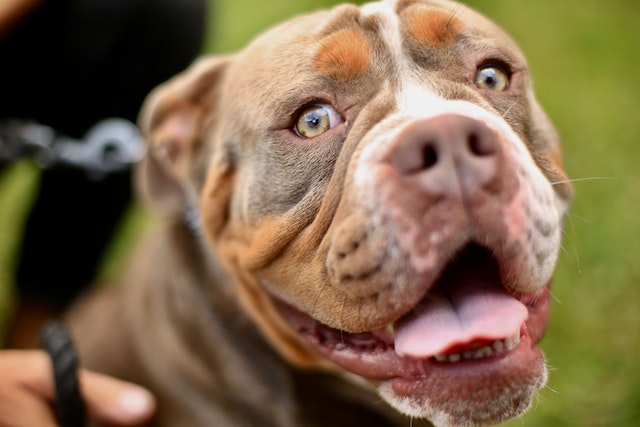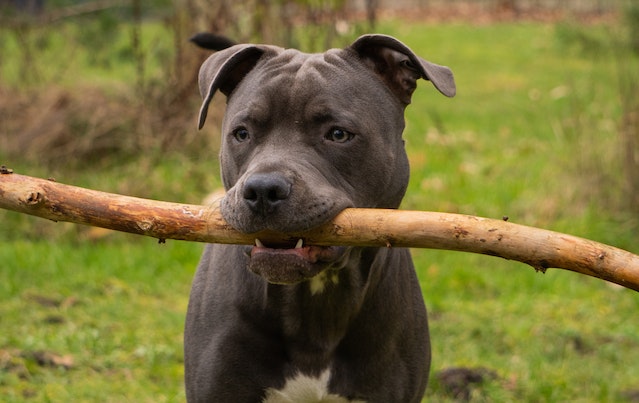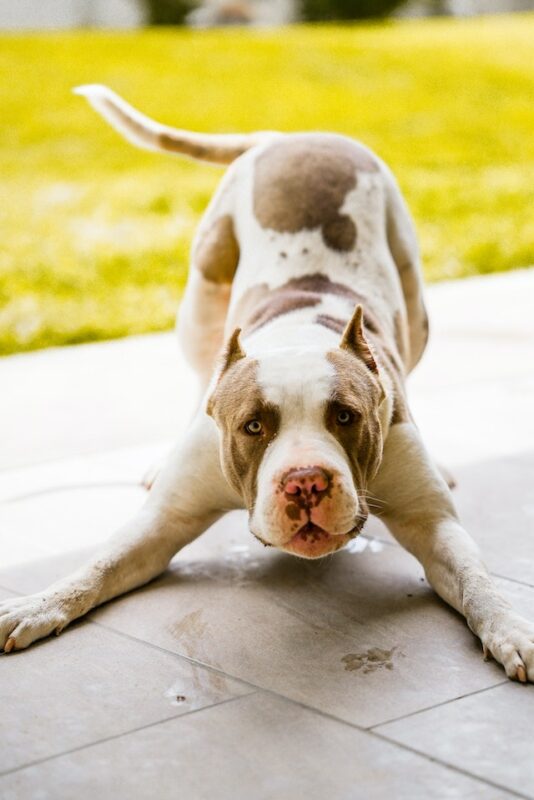Common Pit Bull Health Issues and Why Pet Insurance is Necessary
Posted: 06/09/2023 | BY: Jenna Bruce | Categories: Dog , Health problems , Pet care
American pit bull terriers are muscled and athletic dogs with big, goofy grins. The breed can trace its roots back to early 19th century England when a breeder crossed a bulldog with a terrier to create this impressive specimen. As with any breed, there are pit bull health issues pup parents should be aware of.
In this blog post we’ll take a look at the origins of the American pit bull terrier as well as some of their most common health issues and why pup parents should absolutely consider getting pet insurance early!

The Pit Bull Origin
From their beginning, pit bulls have been described as courageous, spirited, loyal and gentle dogs. Back in the day they were often used as multipurpose working dogs, driving livestock, protecting property, and going on hunts. And of course, they were also family companion dogs, often called “nanny dogs” because they were so good looking after children.
Sadly, even back in “ye olde England,” pit bulls were often used for inhumane blood sports including dog fighting and bull baiting. This has continued throughout the years, even as they were brought over to the United States in the mid-1800s, and is why the breed is still unfairly stereotyped as aggressive.
Throughout the 1900s and to modern day, pit bulls have continued to be affectionate companion dogs. And, because of their courage and athleticism, pitties have also made excellent service and therapy dogs, police and military dogs, and even search-and-rescue dogs.
3 Common Pit Bull Terrier Health Concerns
Every dog breed comes with their own unique quirks and character traits, personalities and yes even health issues. The American pit bull terrier is no different. The following are some of the most concerning health problems that pit bull parents should be aware of.
Foreign Body Obstruction
We often hear about how curious cats are, but dogs are also curious by nature. Most canines love nothing more than to explore their surroundings to discover new smells, sights and tastes. Unfortunately, this curiosity can often get them into trouble.
Dogs, including pitties, are notorious for ingesting odd things they shouldn’t like sticks, rocks, articles of clothing, paper wrappers, bones and more. Pitties in particular love chewing on just about anything, so pup parents really need to be aware of the risk of a blockage developing.
Blockages are potentially life-threatening health conditions that occur when a dog has ingested something big enough that it becomes lodged in their intestines. When this happens, the dog requires immediate life-saving surgery to remove the item.
And here’s the first reason why pet insurance for this breed is important: Foreign object removal surgery isn’t cheap. Endoscopic procedures commonly cost between $800 and $2,800, while open surgery, such as laparotomy, may range from $2,000 to $3,500. And this isn’t even including the necessary hospitalization of at least one night. In total, a pup parent could get hit with an unexpected bill of $5,000 or more. A pet insurance plan can offset these costs, sometimes by as much as 90%.

Canine Cruciate Ligament Injury
Pitties are one of the top breeds that are genetically predisposed to cranial cruciate ligament (CCL) tears known as the ACL tear in humans. We’ve always believed that CCL ruptures were similar to ACL ruptures in humans, in that it was caused by some sort of injury or trauma. But that’s not really the case.
“What we’re learning now is that CCL tears are found to be more of a genetic predisposition rather than an athletic injury,” said Katie Clark, RVT (Emergency Veterinary Nurse with Veterinary Emergency Group). So while any breed of dog can in fact tear their CCL through some sort of injury, most cases of these tears are found in breeds that happen to have a higher hereditary risk.
According to Clark, something else to note is that at least half the dogs that have a cruciate ligament problem in one knee will likely, at some point in the future, develop a similar issue in the other knee.
Depending on the severity of the tear, surgery may be required as it is the only way to permanently stabilize the joint. And here is where a pet insurance policy will also come in handy: According to CareCredit, this surgery can cost, at a minimum, between $2,000 and $4,000. And keep in mind, over half of the dogs that develop a CCL tear in one knee will develop it in the other. So you could potentially be looking at $4,000 to $8,000 in total.
Cost
It’s very important to mention that you should enroll your pittie into a pet insurance plan as early as possible, when they are young and healthy. This is because most insurance providers have a required waiting period of 6 to 12 months before CCL surgery coverage kicks in.
Something else to mention, some insurance companies have what are called “bilateral conditions exclusions.” This essentially means if your pup had a CCL issue in the past, fixing their other leg would be considered a “pre-existing” condition and it would be excluded from coverage. Remember that more than half of pitties with CCL tears in one leg will develop them in the other. Insurers know this and also want to protect themselves.
All of this is to say that if you have a pit bull it is really, really important to enroll them into a pet insurance plan when they are still a puppy. You will save yourself a lot of money and heartache down the road if you do!
Aortic/Subaortic Stenosis
Subaortic stenosis (SAS) is a narrowing of the area underneath the aortic valve. This causes a blockage and reduces the amount of blood flow through the heart. The narrowing can be mild, moderate or severe. In moderate or severe cases, the heart is forced to work harder and this can potentially lead to poor heart health outcomes.
SAS is commonly seen in pit bull terriers and signs usually present themselves in the first year of life. In mild cases no signs are evident. Moderate and severe cases of SAS may present with weakness, difficulty breathing, and fainting. In extreme cases, sudden death may be the result.
Moderate and severe cases of SAS typically require daily medication to reduce the intensity of the heart’s work. Pup parents are also asked to control the amount of workload on the heart. This means trying to control their pup from being too excited or active.
There are several (costly) surgical procedures as well as minimally invasive procedures (balloon catheterization) that can reduce the obstruction successfully. The best course of treatment should be discussed with your vet. But in any case, you are looking at many vet visits, diagnostic testing, daily medications and/or surgery. All of these can add up to one very large vet bill and why we very much recommend you consider enrolling your pup into a pet insurance plan as soon as possible.

It Only Takes Two Minutes
Pitties are one of those lovable breeds that come with a lot of potentially expensive health issues. Ensure you can give your pup the care they need and protect your savings at the same time by getting a free customized quote from top insurance providers in the country.

This blog post was made possible through a collaboration with Katie Clark, RVT (Emergency Veterinary Nurse with Veterinary Emergency Group). Katie’s content can be found on her Instagram channel @katiethevetnurse and on her website https://Katiethevetnurse.com.
References:
- https://www.carecredit.com/well-u/pet-care/cat-and-dog-acl-surgery-cost-and-financing “Dog ACL (CCL) Surgery Cost and Financing Options”
- Ontiveros, E.S., Stern, J.A. Genetics of canine subvalvular aortic stenosis (SAS). Canine Genet Epidemiol 8, 4 (2021). https://doi.org/10.1186/s40575-021-00103-4
- https://www.vet.cornell.edu/hospitals/companion-animal-hospital/cardiology/aorticsubaortic-stenosis “Aortic/Subaortic Stenosis,”
- https://vetmedbiosci.colostate.edu/vth/services/orthopedic-medicine/canine-cruciate-ligament-injury/ “CANINE CRUCIATE LIGAMENT INJURY”
Disclaimer
The information contained on this blog is intended for informational and educational purposes only and should not be construed as medical advice. It is not a substitute for professional veterinary care. Always consult with your veterinarian before making any changes to your pet's health care or treatment plan.
The authors of this blog are not veterinarians and do not claim to be experts in pet health. The information provided here is based on our own experiences and research, as well as information from reputable sources. However, we cannot guarantee the accuracy or completeness of this information.
We encourage you to do your own research and consult with your veterinarian before making any decisions about your pet's health.
Previous post
What is Your Pet Trying to Tell You?Compare top pet insurance providers plans.
Enter your dog’s age in years and months to calculate their age equivalent to human years.
Calculate your dog’s ageEnter your cat’s age in years and months to calculate their age equivalent to human years.
Calculate your cat’s age